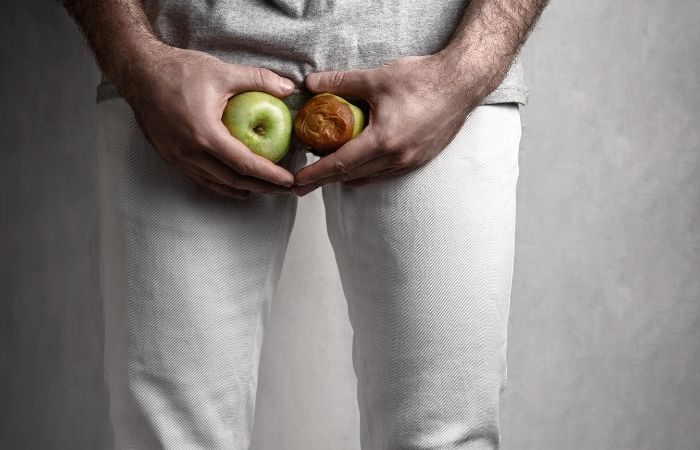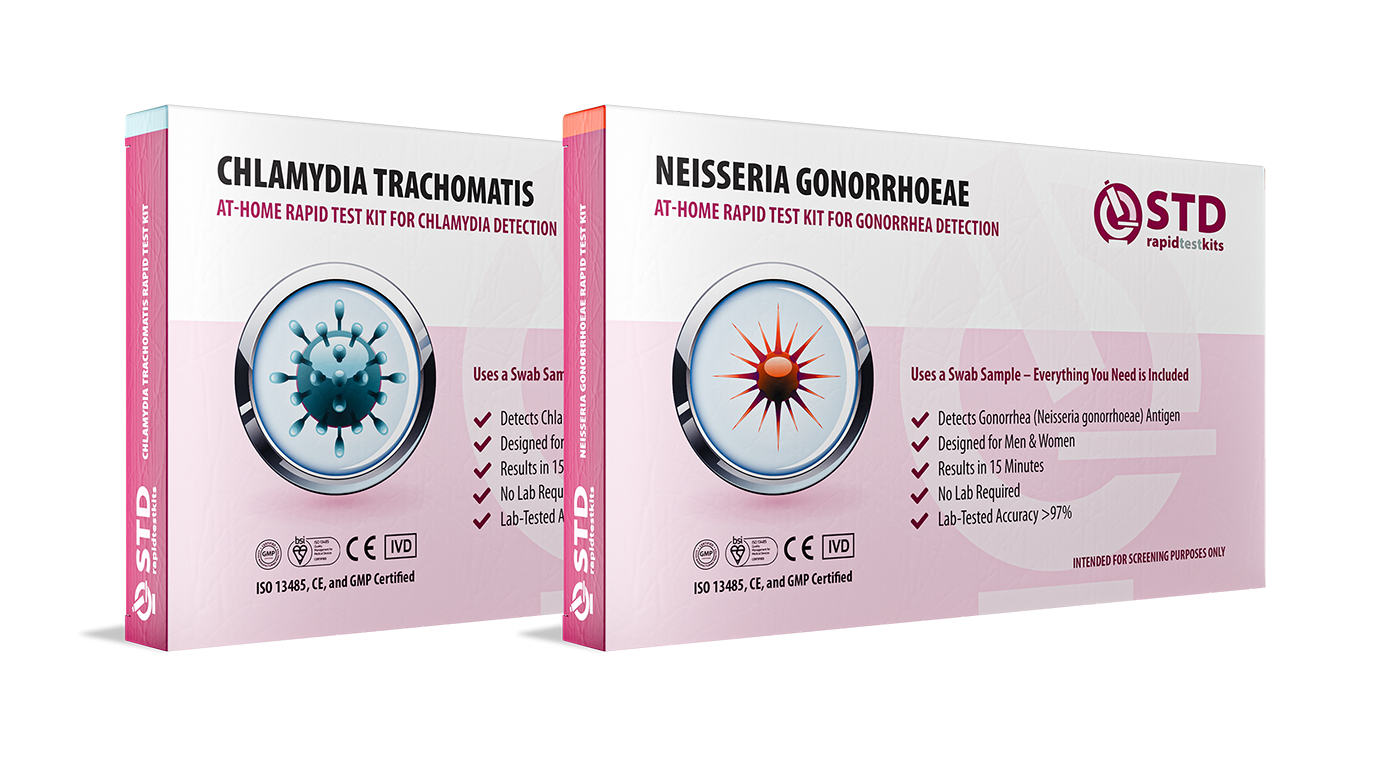Quick Answer: Testicular pain after sex can signal an STD like chlamydia or gonorrhea, but can also stem from arousal, strain, or inflammation. If it lingers, get tested.
Common Causes of Testicular Pain After Sex
Testicular discomfort after ejaculation is more common than you think. While STDs are one potential cause, there are also mechanical, structural, and inflammatory reasons your balls might hurt post-sex:
- Overstimulation: Prolonged arousal without ejaculation
- Rough sex: Trauma or impact to the groin
- Pelvic floor tension: Spasms or tightness that refer pain to the testicles
- Epididymitis: Inflammation of the epididymis, often STD-related
Most of these conditions are temporary. But when the pain lasts for hours, worsens, or comes with swelling, fever, or discharge, it could be time to consider an infection.

People are also looking for: Your Balls Are Swollen and It’s Not Sexy: It Might Be Orchitis
Epididymitis: The #1 STD-Related Cause of Ball Pain
Epididymitis is a painful inflammation of the coiled tube behind the testicle that stores and carries sperm. It’s most often caused by chlamydia or gonorrhea in sexually active men under 35, but can also stem from UTIs or other infections in older adults.
Symptoms may include:
- Aching or sharp pain in one or both testicles
- Swelling or warmth in the scrotum
- Pain during ejaculation or urination
- Fever or chills in more severe cases
If you feel this kind of pain after sex, especially with other STI symptoms, it’s worth getting tested immediately. Untreated epididymitis can lead to abscesses, chronic pain, and infertility.
When It’s Chlamydia or Gonorrhea
Both chlamydia and gonorrhea can infect the urethra and spread to the testicles through the vas deferens. While most infections are asymptomatic at first, they can cause complications like:
- Burning or pain while peeing
- White, yellow, or green penile discharge
- Testicular tenderness or aching after ejaculation
If you've had unprotected sex and notice any of these, especially paired with post-ejaculatory ball pain, don't wait. Get screened. The longer you let these infections sit, the greater the risk of long-term damage.
Non-STD Causes of Post-Sex Testicle Pain
Not all testicular pain means you have an STD. Plenty of other factors can create discomfort after sex, including:
- Blue balls (epididymal hypertension): Prolonged arousal without ejaculation can cause pressure and aching. It’s not dangerous but can feel intense.
- Varicocele: Enlarged veins in the scrotum that worsen with sexual activity or standing for long periods.
- Inguinal hernia: A bulge or tear in the groin wall may cause pain referred to the testicles during or after exertion.
- Testicular torsion (emergency): If the testicle twists on the spermatic cord, it causes sudden, severe pain. This needs emergency care.
What sets STDs apart is the pattern: pain that comes back consistently after sex, especially when combined with urinary or discharge symptoms, should raise red flags.
Check Your STD Status in Minutes
Test at Home with RemediumChlamydia & Gonorrhea Test

 For Men & Women
For Men & Women Results in Minutes
Results in Minutes No Lab Needed
No Lab Needed Private & Discreet
Private & DiscreetOrder Now $49.00 $98.00
For all 2 tests
“I Thought It Was Just Blue Balls,” When It’s Actually Something Worse
We’ve all heard the joke, blue balls. It’s become shorthand for being left hanging. But here’s the deal: if you’re brushing off persistent testicular pain as “just blue balls,” you could be missing something serious. While epididymal hypertension (the technical term) is real, it typically resolves shortly after arousal fades or ejaculation happens.
If your pain:
- Lasts more than an hour or two
- Feels sharp, not dull
- Comes with swelling, heat, or discharge
- Worsens after every sexual encounter
Then it’s not just blue balls. It could be epididymitis, a brewing infection, or even something more dangerous like torsion. Don’t let a meme delay your diagnosis.
Case Study: “I Thought It Was from Rough Sex. It Was Gonorrhea.”
Jay, 24, figured his testicular pain came from the aggressive sex he'd had with a new partner. There’d been tugging, a few slaps, some deep thrusts, it felt intense but consensual. The next day, his left testicle ached. He popped some ibuprofen and figured it would pass.
“It got worse by day three. I couldn’t even sit comfortably. There was this weird discharge too. I still didn’t think STD, I thought it was just bruising.”
Jay finally took an at-home STD test and tested positive for gonorrhea. Turns out the infection had inflamed his epididymis. With antibiotics, the pain went away in under a week. But his urologist warned: another week untreated, and it could’ve caused permanent damage.
This is your nudge, if it’s not getting better, don’t guess. Test.
Why “One Ball Hurts” Could Still Mean an STD
Some people assume if only one testicle hurts, it must be mechanical, not an infection. But infections don’t follow symmetry rules. Chlamydia, gonorrhea, and even syphilis can localize on one side if the bacteria travel unevenly through your vas deferens or lymphatic system.
In fact, most cases of epididymitis caused by STDs affect just one testicle, typically the left. Why? The left spermatic vein drains differently and more slowly, which can lead to inflammation or congestion.
So don’t let “just one ball” lull you into waiting. It still deserves a test, and possibly antibiotics, before it becomes a bigger issue.

People are also looking for: This Common STD Could Be Why Your Testicles Hurt
The Mental Load of Testicular Pain: Shame, Fear, and Avoidance
No one wants to talk about aching balls. It’s embarrassing, right? It feels too intimate, too weird, too easy to brush off. That’s why many people delay care, especially men or masc folks who were taught to “tough it out.”
But untreated STIs don’t care about your pride. Ignoring pain can mean letting it evolve into infertility, chronic inflammation, or sexual dysfunction. And that’s a much heavier emotional load to carry later on.
You deserve to know what’s going on. Testing isn’t just physical, it’s a relief valve. It answers the “what if?” and puts the power back in your hands. At-home kits make it easier than ever to find out discreetly.
Pain after sex is a message. Don’t ignore the envelope just because you're scared of what's inside.
Signs You Should Get Tested
If you’re sexually active and your testicles hurt after sex, there are a few clear signs that testing for STDs is warranted:
- Testicular pain that lasts more than a few hours post-ejaculation
- Swelling, heat, or tenderness in the scrotum
- Discharge from the penis
- Burning during urination or ejaculation
- Fever or chills accompanying scrotal pain
These symptoms are common in chlamydia, gonorrhea, and even syphilis. If you've had new or unprotected sex recently, don’t second-guess. Get tested and rule out the big stuff first.
How STD Testing Works for Testicular Pain
Most people assume a standard urine test will cover everything, but that's not always true. When it comes to testicle-related symptoms, here’s what you need to ask for:
- Urine NAAT: For chlamydia and gonorrhea
- Urethral swab: May be needed if urine is negative but symptoms persist
- Ultrasound: If epididymitis, torsion, or structural issues are suspected
Check Your STD Status in Minutes
Test at Home with Remedium3-in-1 STD Test Kit

 For Men & Women
For Men & Women Results in Minutes
Results in Minutes No Lab Needed
No Lab Needed Private & Discreet
Private & DiscreetOrder Now $69.00 $147.00
For all 3 tests
How to Prevent Testicular Pain From STDs
The best way to prevent post-sex testicular pain linked to STDs is to protect yourself before the pain ever shows up. That means:
- Condoms and barriers: Use condoms during vaginal, anal, and oral sex to reduce transmission of gonorrhea and chlamydia
- Regular screening: Test every 3–6 months if you’re sexually active with new or multiple partners
- Open conversations: Ask partners about their last test, symptoms, or risk factors before getting intimate
Also important: don’t push through pain. If sex causes aching or swelling every time, something’s not right, either with how you're having sex or what’s going on inside your body. Get it checked.
Can You Still Have Sex With Testicle Pain?
If your testicles hurt after sex, don’t just try to push through it. Continuing to have sex while infected can make symptoms worse, and increase your risk of transmitting an STD to your partner.
Before resuming sex, make sure:
- You’ve ruled out infection with testing
- Any diagnosed STI has been fully treated
- Your partner has also been treated if needed
- Pain has resolved and you’ve gotten clearance from a provider if the pain was serious
Pain is your body’s warning system. Respect it. Don’t ignore ball pain, especially if it’s new, sharp, or getting worse after each sexual encounter.
What If It’s Not an STD?
If your tests come back clean, the next step is looking at other causes. A urologist can help rule out structural or hormonal issues, such as:
- Varicoceles or hydroceles
- Nerve entrapment or referred pelvic pain
- Prostatitis (inflammation of the prostate)
- Muscle strain or postural issues from intense activity
Sometimes ball pain isn’t about infection, it’s about tension, circulation, or mechanics. But you won’t know until you rule out the most common cause first: STIs.
FAQs
1. Can chlamydia cause testicle pain?
Yes. It’s one of the most common causes of epididymitis, which can cause post-ejaculatory testicular pain.
2. How do I know if my pain is from an STD?
Pain that follows sex and comes with swelling, discharge, or urination issues should trigger STI testing immediately.
3. Can gonorrhea affect my testicles?
Absolutely. Gonorrhea can inflame the urethra and epididymis, leading to aching or swelling.
4. Is “blue balls” a real thing?
Yes. Epididymal hypertension can cause discomfort from prolonged arousal without ejaculation, but it’s temporary and non-infectious.
5. How soon should I get tested?
Ideally within a week of symptoms. Use STD Rapid Test Kits for fast, discreet results.
6. Can I pass an STD to my partner if my only symptom is ball pain?
Yes. You can be infectious even if testicular pain is your only symptom.
7. Is testicle pain an emergency?
If the pain is sudden and severe, it could be torsion, go to the ER. Otherwise, schedule an STI test or see a urologist.
8. What if my tests are negative?
You may still have a non-STD issue. Ask your provider about imaging or referral to a urologist.
9. Can untreated STDs affect fertility?
Yes. Untreated chlamydia or gonorrhea can lead to infertility in men due to scarring and inflammation.
10. Should my partner get tested too?
Always. If one of you tests positive, both need treatment to prevent ping-pong infections.
Don't Brush It Off
Testicle pain after sex isn’t something to brush off or laugh about. Whether it’s a dull ache or sharp sting, your body’s telling you something, and it might be warning you about an STD. Chlamydia, gonorrhea, and epididymitis are all treatable when caught early. But if ignored, they can cause lasting damage to your fertility, comfort, and relationships.
If you’re feeling pain after sex, don’t panic, but don’t wait either. Rule out infections first. Use at-home testing if you need privacy. And if your results come back clean? That’s the green light to dig deeper with a urologist. Either way, your balls deserve better than silence.
Sources
1. Epididymitis – STI Treatment Guidelines (CDC)
2. Testicle Pain & STIs: How Chlamydia and Gonorrhea Cause Epididymitis (Healthline)
3. Epididymitis: Causes, Symptoms & Treatment (Mayo Clinic)
4. What is Epididymitis? Causes & Treatment (Verywell Health)
5. Common Causes of Testicular Pain Including STIs (Urology of Greater Atlanta)










